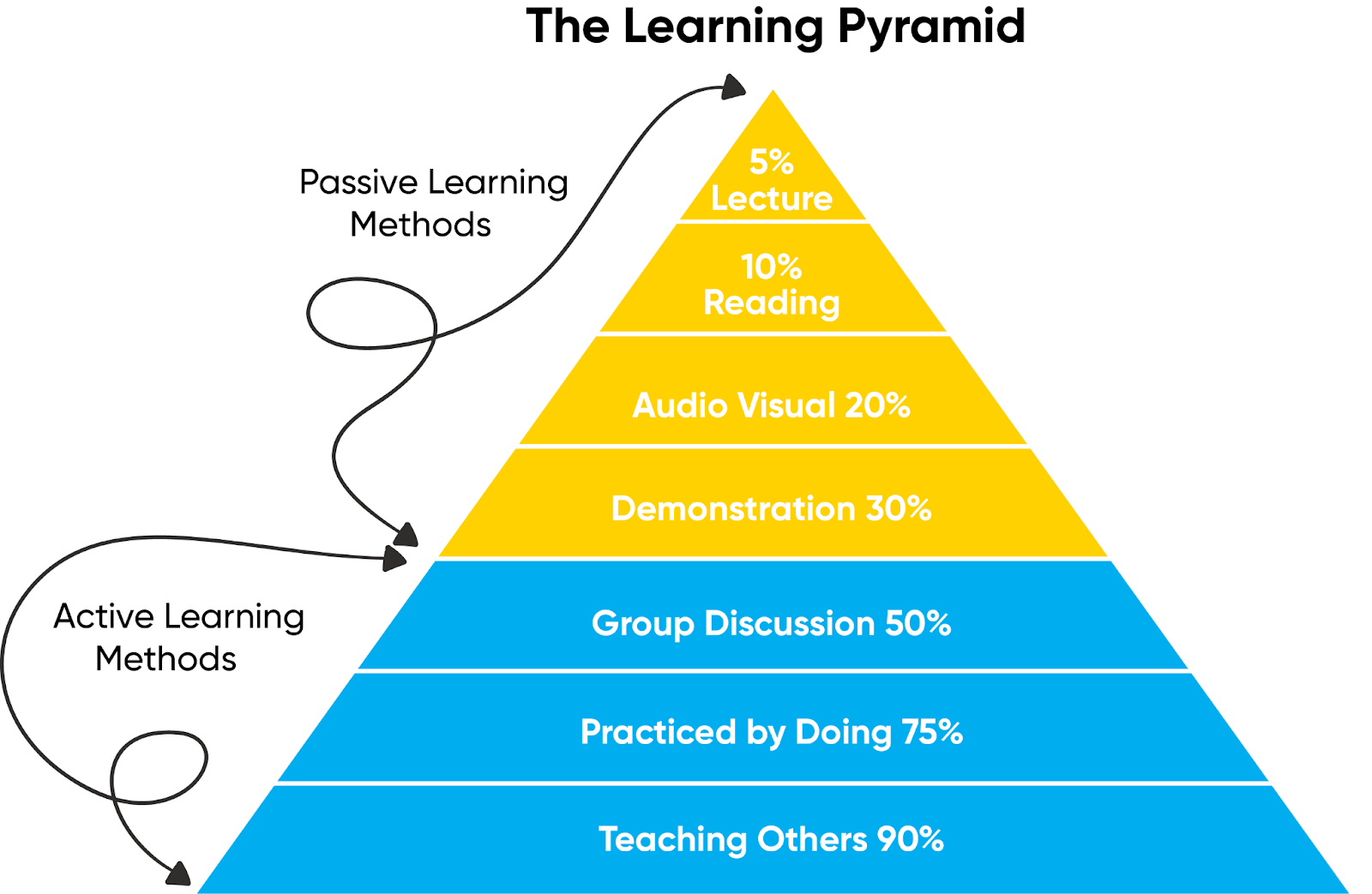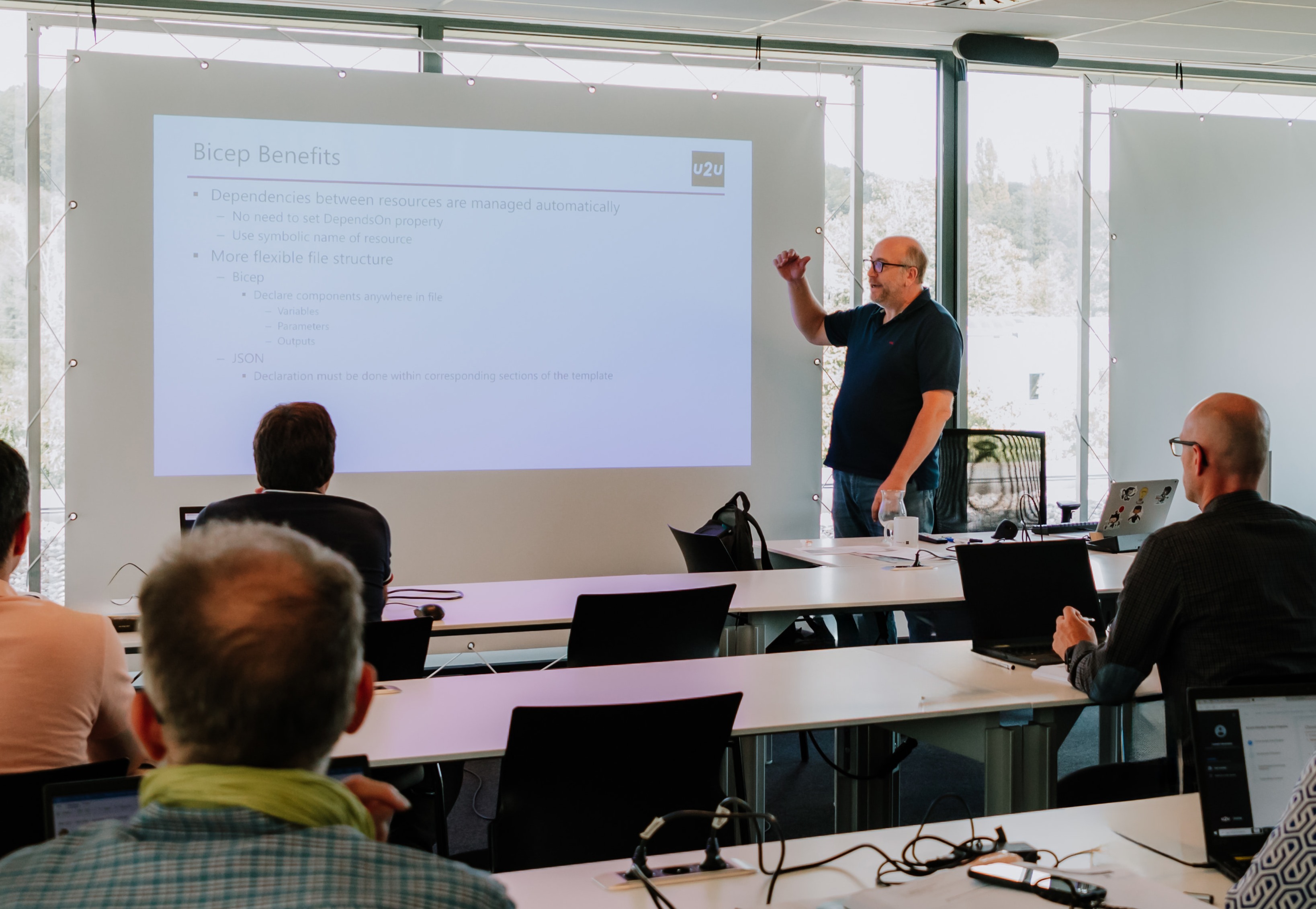
Why Instructor‑Led Training is the Most Effective Learning Approach
In the fast-paced IT industry, training decisions matter. You might be considering various learning methods – from self-paced online modules to on-the-job reading – but research shows that Instructor-Led Training (ILT) yields superior results. Unlike passive e-learning or solitary study, ILT engages participants actively in a structured, face-to-face (or live online) environment. The outcome? Higher knowledge retention, better motivation, and more effective skill development.
The Learning Pyramid: High Retention Through Active Learning

The “Learning Pyramid” illustrates average retention rates: passive methods like lecture and reading (top) yield very low retention, whereas active methods like practice and teaching others (bottom) yield the highest retention. Studies by the National Training Laboratories (NTL) found that learners remember only ~10% of what they read but up to ~90% of what they teach to others . In other words, simply reading a manual or listening to a lecture leads to shallow learning, while actively doing and explaining concepts leads to deep, lasting knowledge.
ILT leverages this principle by incorporating the most effective learning activities. During a typical instructor-led session, participants don’t just listen – they see demonstrations, discuss in groups, practice by doing, and sometimes even teach or present to peers. These active elements correspond to the highest tiers of the learning pyramid (discussion, practice, teaching), which is why ILT can achieve retention rates of 70–90%, compared to the 10–20% range for passive self-study . Simply put, ILT turns learning into an active, engaging process, rather than a one-way transmission of information.
Research-Backed Advantages of ILT
Academic research strongly supports the benefits of ILT’s active and guided approach. Consider the following evidence-based insights:

-
Active Learning Outperforms Lectures
A massive meta-analysis of 225 studies found that students in active learning classes performed significantly better on exams than those in traditional lectures, and were 1.5× less likely to fail the course. In fact, the researchers concluded that active learning should be the preferred, “empirically validated” teaching practice in STEM education. ILT classes naturally incorporate active learning – through discussions, problem-solving exercises, and Q&A – leading to higher achievement than passive listening alone. This aligns with Kolb’s experiential learning theory, which says effective learning cycles through concrete experience, reflection, conceptualization, and experimentation rather than just hearing concepts. -
Guidance Prevents Cognitive Overload:
Completely unguided or “discover-it-yourself” training can overwhelm learners. Research shows that novice learners left to self-direct often become frustrated and learn less effectively . Kirschner et al. (2006) famously argued that minimal guidance during instruction does not work – when working memory is overtaxed by unguided problem-solving, little gets retained in long-term memory. ILT, by contrast, provides expert guidance and structure. Instructors break down complex topics, provide clear explanations, and give feedback, reducing cognitive load so that participants can build knowledge step by step. Especially for challenging IT skills, a knowledgeable instructor’s guidance can mean the difference between confusion and “aha!” moments. -
Social Interaction Deepens Understanding:
Learning is a social endeavor. Vygotsky’s theory of the “Zone of Proximal Development” teaches that learners can achieve more with expert or peer support than alone. ILT capitalizes on this by bringing people together in the classroom (physical or virtual). Trainees can ask questions, hear others’ perspectives, and engage in group activities that solidify their understanding. Explaining your thinking in a discussion or tackling a problem as a team leads to deeper processing of the material. Misconceptions can be caught and corrected in real time. This social dimension of ILT echoes Hattie & Timperley’s findings on feedback: immediate, specific feedback is one of the most powerful influences on learning success, with an effect size (~0.79) among the highest of any educational intervention . In an ILT setting, both instructors and fellow learners provide ongoing feedback – something online videos or books simply cannot do.
Motivation and Accountability

Another often-overlooked advantage of ILT is the built-in motivation and accountability it provides. In an instructor-led course, participants are part of a scheduled, interactive session – they can’t hit the pause button and wander off. The live dynamic encourages attendees to stay engaged and participate. There’s an element of accountability: the instructor and peers notice if someone is absent or disengaged, which nudges learners to show up prepared and on time.
This structured environment helps prevent the procrastination or distraction that often plagues self-paced e-learning. Moreover, the energy of a group classroom can be highly motivating. Learners report being more committed and involved when training with others, as the group dynamic creates a positive pressure to contribute. In short, ILT adds a human touch – the encouragement, real-time interaction, and social presence keep learners on track and motivated to succeed.
Relevance and Flexibility in Real Time

ILT also excels at making learning relevant and adaptive. A skilled instructor can tailor examples, answers, and emphasis to the specific needs of the trainees. For IT professionals, this is crucial – generic online content might not address the particular technologies or use-cases that matter to your team. In an ILT session, attendees can pose questions like, “How does this apply to our architecture?” or “What if scenario X happens?” and get immediate, context-rich answers. The trainer can adjust the depth or pace of the material on the fly, ensuring no one is left behind.
This real-time flexibility means ILT can connect the dots between theory and practice in your organization’s context. Learners see directly how the new skills or knowledge apply to their day-to-day work, which boosts both understanding and retention. This contextual learning approach makes training far more impactful than one-size-fits-all modules. It also allows incorporation of the latest industry trends or company-specific tools during the course. The result is training that is not only instructive but immediately applicable.
Reduced Cognitive Load, Better Skill Development

Mastering complex IT topics can be mentally demanding. ILT helps manage the cognitive load on learners. In a live class, the instructor structures and paces the content in a pedagogically sound way – chunking information, using analogies, and highlighting key takeaways – so that participants’ brains aren’t overwhelmed with too much at once. If a concept is particularly difficult, the instructor can recognize puzzled looks or questions and revisit the topic using a different approach. This guided pacing is informed by cognitive science: learning happens best when new information is introduced in manageable bits and immediately reinforced.
Additionally, ILT focuses on learning-by-doing, which turns abstract knowledge into practical skills. Through hands-on labs, coding exercises, or role-play scenarios, learners move information from theory into practice, easing the transfer to long-term memory . They get to apply concepts under an expert’s supervision, which builds confidence and competence. By the end of an ILT course, attendees haven’t just read about new skills – they have actively practiced them, with feedback, which greatly increases retention and proficiency.
Comparison: ILT vs. Other Learning Methods
To put things in perspective, here’s a quick comparison of Instructor-Led Training with other common learning methods (self-paced e-learning, self-study, etc.) on key factors:
| Feature | ILT (Instructor-Led) | Self-Paced E-Learning | Self-Study Books | Informal Self-Learning |
|---|---|---|---|---|
| Interaction | High – live engagement with instructor & peers | Low – limited interactivity (mostly one-way content) | None – independent reading | None – independent search |
| Direct Feedback | Yes – immediate Q&A, feedback on exercises and quizzes | Limited – maybe quizzes or forums, but not real-time | No – no immediate feedback | No – no feedback source |
| Hands-on Practice | Yes – extensive practice labs & activities | Moderate – some simulations or exercises | Low – mostly theoretical practice | Low – ad-hoc, unstructured practice |
| Adaptive to Needs | Yes – instructor adjusts to learners’ level and questions | Limited – onesize-fits-all modules (some branching possible) | No – static material | No – learner must figure out needs alone |
| Knowledge Retention | High (70–90% with active methods) | Moderate (mixed, often ~30–50% | Low (10–20% with reading) | Very Low (<10% with casual info browsing) |
As the table suggests, ILT combines the best of both worlds – the rich interaction and adaptiveness of a live teacher plus the proven high-retention techniques of active learning. Other methods have their place (e-learning can be convenient for quick updates, and self-study works for reference materials), but for deep skill-building, they fall short on engagement and effectiveness.
Why ILT Is the Best Choice
Bringing together the points above, Instructor-Led Training emerges as a powerful, science-backed learning approach for IT teams. ILT isn’t just tradition or intuition – it’s supported by decades of research and evidence. It maximizes knowledge retention by employing active techniques (demonstrations, discussions, hands-on practice) that embed learning in long-term memory . It keeps learners motivated and on track through human interaction and accountability. It offers real-time customization and feedback, ensuring that training is relevant and doubts are resolved immediately. And it converts knowledge into practical skills under the guidance of experts, which is critical in a field where knowing how to do something is just as important as knowing what it is.
In contrast, self-paced or purely online methods often see learners “tune out” or give up, resulting in low completion rates and superficial learning. ILT avoids these pitfalls by creating an immersive learning experience where participants are active contributors, not passive consumers. The collaborative environment also builds team cohesion and encourages a culture of continuous learning – valuable side benefits for any organization.
In summary, for training that demands true understanding, application, and skill mastery – Instructor-Led Training is the proven best choice. It combines effective strategies, provides the supportive atmosphere learners need, and consistently outperforms other methods in delivering lasting results . Especially in the ever-evolving tech world, investing in ILT for your team means investing in learning that sticks – and ultimately, a smarter, more capable workforce.
Contact Us
-
Address:
U2U nv/sa
Z.1. Researchpark 110
1731 Zellik (Brussels)
BELGIUM - Phone: +32 2 466 00 16
- Email: info@u2u.be
-
Monday - Friday: 9:00 - 17:00
Saturday - Sunday: Closed
Say Hi
Thanks! We will respond as soon as possible.

